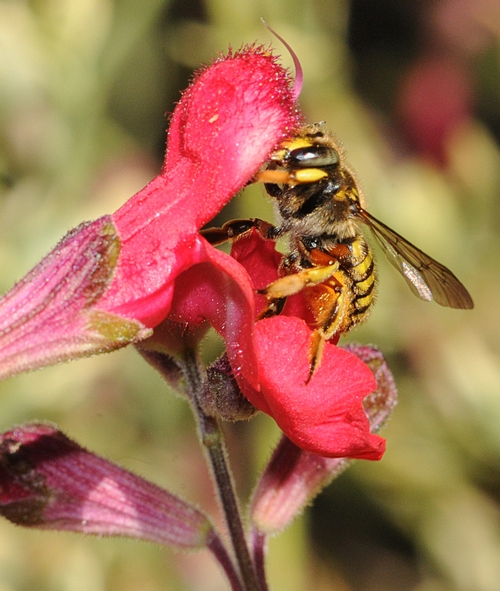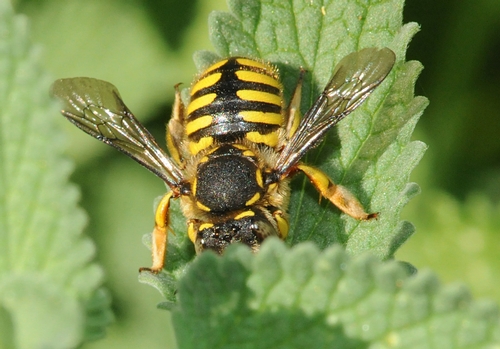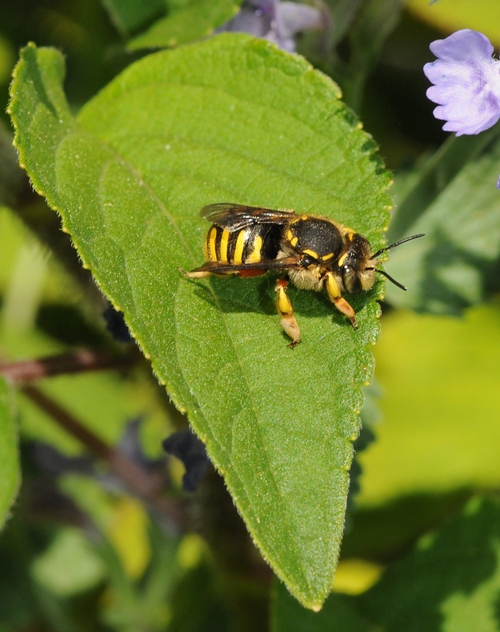Aug 23, 2010
When this insect flashes by you in your garden, at first glance you think: "Yellow jacket? Paper wasp? What's that?"
Then it lands and you realize it's neither.
It's a bee.
The insects buzzing in our catmint last weekend were wool-carder bees, Anthidium manicatum (Linnaeus), as identified by several UC Davis entomologists: Tom Zavortink of the Bohart Museum of Entomology; native pollinator specialist Robbin Thorp, emeritus professor of entomology, and Lynn Kimsey, director of the Bohart Museum of Entomology.
Regarding the carder bee, Zavortink teamed with Sandra Shanks, then of the Bohart Museum, to write a scientific note, "Anthidium manicatum (Linnaeus) (Hymnoptera: Megachilidae in California)," published in the July 2008 edition of the journal Pan-Pacific Entomologist.
"The Palaearctic wool-carder bee Anthidium manicatum (Linnaeus, 1758) was introduced into New York state, presumably from Europe, before 1963 (Jaycox 1967)," Zavortink and Shanks wrote. However, it wasn't detected in California until much later. In 2007, an image of a carder bee from Sunnyvale, Santa Clara County, appeared on the Bug Guide website.
The name, carder bee, comes from its behavior of gathering "down" or "fuzz" from leaves to build its nest.
"Anthidium manicatum builds a linear row of cells, each one being lined and partitioned with cottony down 'carded' from hairy leaves," wrote Christopher O'Toole and Anthony Raw in their book, Bees of the World. "The term 'carder' refers to the teasing out or carding of woollen or cotton fiber with a comblike tool. The female of A. manicatum has five sharp teeth on each jaw and these are her carding tools."
The males are very territorial, the three UC Davis entomologists agreed.
Indeed they are.
The males, about the size of honey bees, buzzed furiously around the catmint last weekend. When they spotted an "intruder," such as a honey bee, they hit it with such force (body slam!) that the victim dropped to the ground.
We also observed carding of the leaves and mating. An Indy-500 male grabbed a female foraging on a catmint blossom.
"It appears that carder bees don't mate in flight like the honey bees do," commented Extension apiculturist Eric Mussen of the UC Davis Department of Entomology faculty.
Zavortink-Shanks and O'Toole-Raw reported that carder bees prefer the downy leaves of such plants as lamb's ear (Stachys lanata).
By the looks of the activity last weekend in our bee friendly yard, it appears that carder bees are also quite fond of catmint (Nepeta) and sage (salvia).
Especially catmint.
Then it lands and you realize it's neither.
It's a bee.
The insects buzzing in our catmint last weekend were wool-carder bees, Anthidium manicatum (Linnaeus), as identified by several UC Davis entomologists: Tom Zavortink of the Bohart Museum of Entomology; native pollinator specialist Robbin Thorp, emeritus professor of entomology, and Lynn Kimsey, director of the Bohart Museum of Entomology.
Regarding the carder bee, Zavortink teamed with Sandra Shanks, then of the Bohart Museum, to write a scientific note, "Anthidium manicatum (Linnaeus) (Hymnoptera: Megachilidae in California)," published in the July 2008 edition of the journal Pan-Pacific Entomologist.
"The Palaearctic wool-carder bee Anthidium manicatum (Linnaeus, 1758) was introduced into New York state, presumably from Europe, before 1963 (Jaycox 1967)," Zavortink and Shanks wrote. However, it wasn't detected in California until much later. In 2007, an image of a carder bee from Sunnyvale, Santa Clara County, appeared on the Bug Guide website.
The name, carder bee, comes from its behavior of gathering "down" or "fuzz" from leaves to build its nest.
"Anthidium manicatum builds a linear row of cells, each one being lined and partitioned with cottony down 'carded' from hairy leaves," wrote Christopher O'Toole and Anthony Raw in their book, Bees of the World. "The term 'carder' refers to the teasing out or carding of woollen or cotton fiber with a comblike tool. The female of A. manicatum has five sharp teeth on each jaw and these are her carding tools."
The males are very territorial, the three UC Davis entomologists agreed.
Indeed they are.
The males, about the size of honey bees, buzzed furiously around the catmint last weekend. When they spotted an "intruder," such as a honey bee, they hit it with such force (body slam!) that the victim dropped to the ground.
We also observed carding of the leaves and mating. An Indy-500 male grabbed a female foraging on a catmint blossom.
"It appears that carder bees don't mate in flight like the honey bees do," commented Extension apiculturist Eric Mussen of the UC Davis Department of Entomology faculty.
Zavortink-Shanks and O'Toole-Raw reported that carder bees prefer the downy leaves of such plants as lamb's ear (Stachys lanata).
By the looks of the activity last weekend in our bee friendly yard, it appears that carder bees are also quite fond of catmint (Nepeta) and sage (salvia).
Especially catmint.
Attached Images:

Female carder bees

Sipping Nectar

Carding

The Evidence

Love on a Catmint